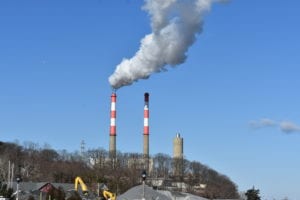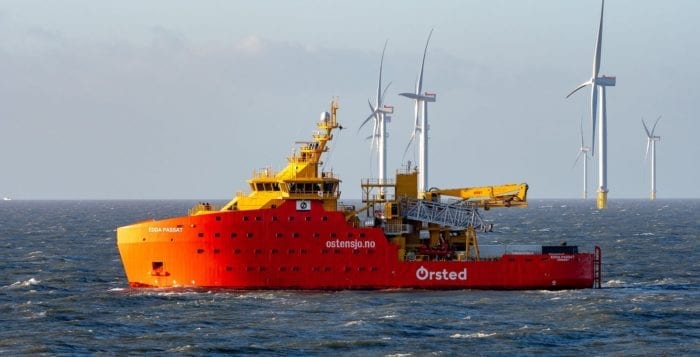Companies, state and Port Jeff village to work out details of offshore wind hub
1,700 megawatts.
That’s enough to power 1 million homes from offshore wind farms to be located off the East End and South Shore of Long Island, or at least that is what New York State officials are hoping for. It’s part of signed contracts with two offshore wind power ventures, looking to set a path toward a statewide carbon-free electricity system in another 20 years.
Port Jefferson could soon become a big part of that.
Announced back in April, one of the wind power projects, whose contract was approved by Gov. Andrew Cuomo (D) July 18, plans to open a headquarters for their joint venture wind project right in Port Jefferson.
The project, dubbed Sunrise Wind, is being headed up by Denmark-based Ørsted, partnering with Massachusetts-based energy company Eversource. The miles of wind turbines set 30 miles east of Long Island are expected to produce 880 megawatts.
“We will lead the way in developing the largest source of offshore wind power in the nation,” Cuomo said during his speech. “We have committed to building 9,000 megawatts of wind power capacity, and we start today by designating companies to build two offshore wind farms for a combined total of 1,700 megawatts of clean energy.”

Cuomo, also joined on stage in Manhattan by former Vice President Al Gore (D), signed on for miles of ocean off the South Shore to be used by Norway-based Equinor’s project Empire Wind which will provide 816 megawatts. This is to work alongside the Ørsted-Eversource project.
Ørsted and Eversource looked to Port Jefferson’s deep harbor as a means of loading and unloading boats making the long trip off the South Shore to make repairs on the wind turbines.
This would become the nation’s largest offshore wind power agreement in U.S. history, though the state has already awarded approximately 4,700 megawatts in renewable energy contracts since March 2018, according to a release from the governor’s office. Collectively, the combined output of renewable energy resources is expected to power nearly 10 percent of New York state homes by 2025.
What this means for Port Jefferson
When Ørsted and Eversource announced its original bid for the state contracts April 3, representatives of the companies said they expected the hub venture to produce around 100 jobs, plus temporary construction jobs while the project is being built. The headquarters and maintenance facility for the project could be run out of Port Jefferson Harbor.
Port Jefferson village Mayor Margot Garant said when approached back in April, the project managers explained service boats will use the village’s harbor and use the pier owned by National Grid. The 35 employees would come through on a two- to three-week basis, loading materials and provisions onto the vessels which would be the ones to travel out and do repairs on the propellers, staying out in the ocean for weeks at a time.
“I think it strengthens our harbor — it strengthens our site in terms of being a partner with Cuomo’s energy plan,” the mayor said. “Any time you can put your community on the map with the state, that it’s a good thing.” — Mayor Margot Garant
State Assemblyman Steve Englebright (D-Setauket) said he has emphasized Port Jefferson’s deep water harbor as a hub for wind energy for years. He sees the Sunrise Wind project as a testbed for Atlantic-based wind energy. Now, he has a grand design in mind, of Port Jeff becoming a model and a wind energy headquarters for the Eastern Seaboard.
“They’re pioneering a project — the first offshore wind project of this scale for the entire Atlantic coast,” he said.
A spokesperson for the Ørsted and Eversource project said the company did not have anything yet to say on specifics relating to Port Jefferson as a hub for the wind farm, and instead referred to existing press releases about the project.
In talks about a land-based location for offices or warehouses, Garant told project managers they may need to look for space close by, but they would be hard pressed to come across thousands of square feet of space like that within village limits.
But with all the talk of green energy, the question of the Port Jefferson power station’s validity remains. The LIPA-owned plant, which recently settled in a tax certiorari agreement with the Town of Brookhaven over its tax assessments, has been running at low percentages for the past several years. It was only 11 percent in 2017, for example. LIPA has said the reduction in taxes may help move the plant toward a clean energy recourse but has not provided more details on what that could entail.
The recently passed state Climate Leadership and Community Protection Act calls for a transition to a carbon-free electric grid for New York by 2040. In response to a query, a LIPA spokesperson said the Port Jefferson power plant will be more than 70 years old by 2030. LIPA has already decommissioned fossil-fuel power plants in Far Rockaway and Glenwood Landing.
“The 880-megawatt Sunrise Wind project will be a key new source of carbon-free electricity for Long Island when it becomes operational in 2024,” said Michael Deering, LIPA director of customer service oversight and stakeholder relations.
Englebright, the chair of the state Assembly’s environmental conservation committee, said that in order to hit milestones of clean energy, plants like Port Jefferson’s will need to be phased out to make way for more renewable energy. He added that LIPA has for now been keepings its options open when it comes to future use of the plant.
“The people in Port Jeff are in need of a respite from fossil fuels and a declining plant,” the assemblyman said.
Garant said she does hope the plant remains viable into the next several years, adding it still sees use, with the stacks flaring up again as people turned on air conditioners during recent heat waves, though she looks forward to what the future may bring.
“As the world changes, things are going to change,” she said.







